苏门答腊中部Panti早始新世S型花岗岩地球化学特征及其新特提斯构造意义
2021-06-30余小清张玉芝王岳军
余小清, 钱 鑫*, 张玉芝, 徐 畅, 王岳军
苏门答腊中部Panti早始新世S型花岗岩地球化学特征及其新特提斯构造意义
余小清1, 2, 钱 鑫1, 2*, 张玉芝1, 2, 徐 畅1, 2, 王岳军1, 2
(1.广东省地球动力作用与地质灾害重点实验室, 中山大学 地球科学与工程学院, 广东 广州 510275; 2.南方海洋科学与工程广东省实验室, 广东 珠海 519082)
苏门答腊地处特提斯构造域与印度洋岛弧系统之内, 区内广泛发育中‒新生代火成岩。这些火成岩对特提斯构造带的延伸及界定具有重要意义, 但目前对于苏门答腊岛的研究程度较低。本文选取苏门答腊岛中部Panti地区的花岗岩进行了岩相学、锆石年代学、锆石原位Hf同位素和全岩地球化学研究。年代学研究表明, Panti花岗岩锆石U-Pb年龄为55.5±0.3 Ma。该套花岗岩具有高SiO2(76.61%~78.37%)和高碱(Na2O+K2O=7.47%~8.21%)的特征, 其分异指数(DI)为95~96, A/CNK为1.08~1.12, 为高分异S型花岗岩。稀土配分模式图及微量元素蛛网图显示其具有强烈的Eu负异常(Eu/Eu*=0.04~0.05), 并亏损Nb、Ta、Sr、P和Ti的特征。且该套花岗岩还具有高Rb/Sr和低CaO/Na2O 值, 同时显示富集的锆石Hf同位素组成(Hf()=−9.1~−2.6)和较老的Hf二阶模式年龄(DM2=1.29~1.70 Ga), 这些特征均指示该套花岗岩来源于古老的变泥质岩的部分熔融。对比缅甸‒滇西‒藏南一带同时期的岩浆事件, 我们认为Panti早始新世高分异S型花岗岩可与滇西腾梁和东盈江同时期花岗岩进行对比, 指示了新特提斯构造岩浆带南延至苏门答腊中部。
苏门答腊中部; 早始新世; 高分异S型花岗岩; 锆石U-Pb年代学; 地球化学; 新特提斯
0 引 言
早白垩世开始, 随着新特提斯洋的俯冲, 印度板块与欧亚板块碰撞, 形成了全球范围内最为壮观的喜马拉雅造山带(Yin and Harrison, 2000)。喜马拉雅造山带构造地质学、年代学及岩浆岩岩石学的研究对理解新特提斯洋的俯冲闭合过程及不同块体的碰撞拼合演化历史具有重要意义(Xu et al., 2012)。目前, 大量研究表明位于班公‒怒江与雅鲁藏布江之间的冈底斯造山带(即拉萨地块南缘)与新特提斯洋的俯冲闭合相关(Chung et al., 2005; Chu et al., 2006; Wen et al., 2008; 朱弟成等, 2008; Zhu et al., 2011)。冈底斯造山带向东可以延伸到藏东南波密‒察隅地区(Liang et al., 2008), 之后向南转入滇西的高黎贡‒腾冲‒梁河‒盈江一带(Xu et al., 2012; 马莉燕, 2013; 马莉燕等, 2013; Ma et al., 2014; Wang et al., 2014), 经缅甸的抹谷变质带(Barley et al., 2003; Searle et al., 2007; Mitchell et al., 2007; Mitchell et al., 2012)南延至苏门答腊岛(Mitchell, 1993; Barley et al., 2003)。也有学者认为西缅甸的白垩纪‒始新世岩浆弧是冈底斯带的延伸, 为新特提斯岩浆带在东南亚的延伸(Wang et al., 2014b)。
东南亚地区是晚古生代或早中生代期间由冈瓦纳北缘分离出来的陆块, 随古特提斯洋俯冲消减拼贴至欧亚大陆东南缘形成的(Metcalfe, 1996; Wang et al., 2018)。其中苏门答腊岛呈NW-SE向狭长分布于东南亚西南岬角, 并被划分为东苏门答腊、西苏门答腊和Woyla地体, 三者分别沿中央构造带和Woyla 缝合线拼贴(图1a、b)。现有研究认为西苏门答腊在中‒晚泥盆世期间, 随着古特提斯洋打开, 与西缅甸和华夏陆块从冈瓦纳古陆北缘向北裂离。早二叠世期间, 受古特提斯洋的俯冲作用, 西苏门答腊发育安第斯型岩浆弧(Barber and Crow, 2003)。而有的学者认为, 随着东古特提斯洋的俯冲, 东苏门答腊地块于中三叠世拼贴至印支地块, 构成了滇缅马苏(Sibumas)地块的一部分(Barber and Crow, 2003, 2009; Wang et al., 2018)。晚中生代, Woyla地体形成, 随着特提斯洋俯冲, 其与苏门答腊主体拼贴(Barber and Crow, 2003)。最近研究表明苏门答腊岛中部地区保存有与新特提斯洋演化有关的始新世碎屑锆石, 证明了新特提斯构造带可以延伸至苏门答腊岛内(Zhang et al., 2019)。此外, 苏门答腊岛的古地磁数据也显示苏门答腊岛Woyla带是藏南地区与新特提斯洋俯冲相关的Incertus洋内弧的南延(Hall, 2012)。但上述研究均集中于沉积岩及古地磁方面, 缺少对相关岩浆岩年代学和地球化学的研究, 因此限制了我们对新特提斯构造带延伸及演化的认识。近期本课题组在苏门答腊岛进行的野外地质调查中, 在中部Panti地区识别出一套始新世花岗岩。本次研究将以这套花岗岩为研究对象, 系统开展岩相学、锆石年代学、锆石原位Hf同位素及全岩地球化学研究, 阐明其岩石成因及构造背景, 进而与区域相关火成岩进行对比, 为新特提斯岩浆带的延伸提供新的证据。
1 地质背景及岩相学特征
苏门答腊的大陆基底被认为由结晶片岩、前石炭纪的沉积单元及时代相当的侵入体组成(Hamilton, 1979)。自古近纪中期起, 印度洋沿巺他海沟斜向俯冲, 在苏门答腊西海岸形成从北西至南东的巨型巴里桑山火山弧, 该火山弧被NW-SE右型走滑断层体系(巺他断层区)切分成多个狭长地块(图1b; 如Mccourt et al., 1996; Barber et al., 2005)。苏门答腊岛前新生代地层主要划分为石炭系‒二叠系Tapanuli群、二叠系‒三叠系Peusangan群和侏罗系‒白垩系Woyla群(Cameron et al., 1980), 且大部分地区被新生代沉积岩和火山岩覆盖。其中西苏门答腊分布有石炭纪地层, 并发育亲华夏体系的低纬度暖水动植物群‒热带维宪期珊瑚藻动植物群(Barber and Crow, 2009)。而东苏门答腊分布有二叠纪地层, 发育高纬度的冷水动物群, 且分布有与锡矿相关的花岗岩(Cobbing, 2005; Barber and Crow, 2009)。至少在晚三叠世前, 西苏门答腊和西缅甸沿中央构造带拼贴至东苏门答腊(滇缅马苏地块西部), 并在中央构造带发育一系列的ES向地堑构造, 且形成盆地(Barber and Crow, 2003)。关于Woyla地体的形成, 有人认为其是晚侏罗世特提斯洋俯冲形成的洋内岛弧和增生杂岩体, 并随着白垩纪特提斯洋闭合拼贴至西苏门答腊(Wajzer et al., 1991; Barber, 2000; Barber and Crow, 2003; Barber et al., 2005), 包含北部的西库莱(Sikuleh)和中部的纳塔尔(Natal)2个古老微陆块(Barber, 2000; Barber et al., 2005); 也有学者认为这些微陆块是在晚侏罗世由澳大利亚裂离而来的(Metcalfe, 1993)。此外Woyla地体还包括了新生代的火山弧岩浆岩(玄武‒安山质火山岩和火山碎屑岩等)、海洋增生杂岩(枕状玄武岩和红色页岩等)和中侏罗世‒早白垩世的杂岩(石英钙质砂页岩)等(Advokaat et al., 2018)。中新世, 随着苏门答腊北部安得曼海的打开, 西苏门答腊和西缅甸逐渐分离(Barber et al., 2005; Barber and Crow, 2008, 2009; Metcalfe, 2011, 2013)。
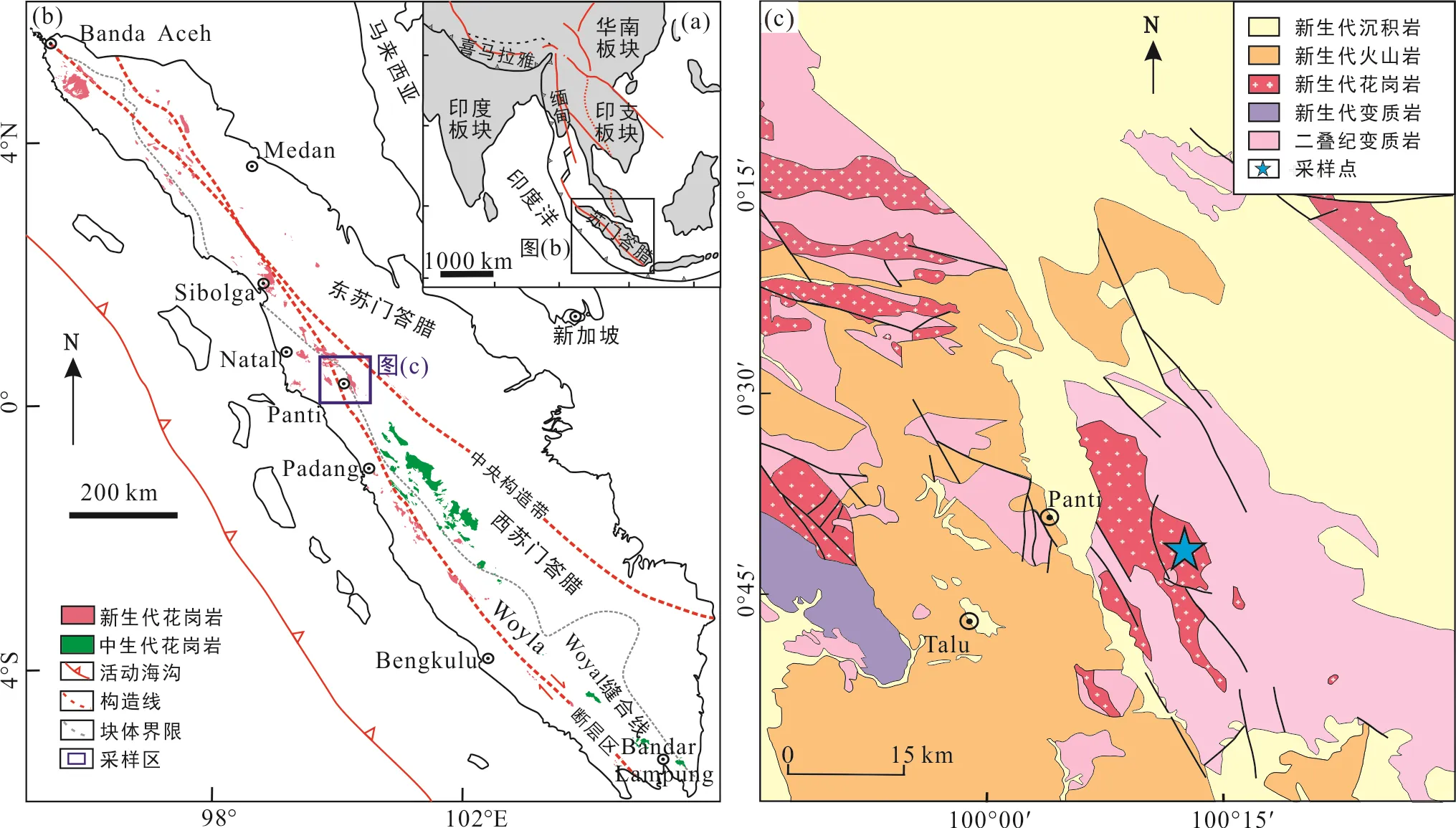
图1 苏门答腊区域构造图(a、b)和研究区地质简图(c)(据Barley et al., 2003; Advokaat et al., 2018)
Panti花岗岩位于苏门答腊岛中部, 处于西苏门答腊与Woyla地体交界处。研究区还出露有大量新生代沉积岩和火山岩, 其中沉积岩包括新近纪石英砂岩、碳质页岩、海绿石页岩、粉砂岩、砾岩和第四纪砂岩; 火山岩主要为中新世层状火山岩、第四纪熔岩及火山碎屑岩为主的冲积层。区内新生代花岗岩普遍侵入二叠纪的板岩、变石英砂砾岩、变石英岩和千枚岩等变沉积岩中, 部分侵入至新生代的变火山岩、变杂砂岩、绿片岩、千枚岩和板岩中(图1c)。
本次研究的花岗岩样品采自Panti东边约6 km处的TANDUNGK UMBANG 花岗岩岩体(坐标为: 00°22′57.25″S、100°07′04.02″E)。Panti花岗岩主要矿物为石英(40%~50%)、斜长石(20%~25%)和碱性长石(20%~30%), 次要矿物有黑云母(5%~8%), 可见少量锆石副矿物(1%~2%), 其中碱性长石中含较多呈条纹结构的条纹长石, 斜长石发育聚片双晶(图2)。
2 分析方法
2.1 LA-ICP-MS锆石U-Pb定年及原位Hf同位素测定
锆石U-Pb同位素定年和原位微区微量元素含量分析在中山大学地球动力作用与地质灾害省重点实验室利用激光剥蚀系统与电感耦合等离子体质谱仪联用(LA-ICP-MS)完成。GeolasHD激光剥蚀系统由COMPexPro 102 ArF 193 nm准分子激光器和MicroLas光学系统组成, ICP-MS型号为iCAP RQ。分析采用的激光束斑为32 µm, 频率为5 Hz。U-Pb同位素定年采用锆石标样91500和Plešovice来进行同位素分馏校正, 采用玻璃标准物质NIST610进行微量元素校正。对分析数据的处理采用软件GLITTER(Griffin et al., 2008)进行。
锆石Hf同位素原位分析是在中山大学地球动力作用与地质灾害省重点实验室利用Geolas HD准分子ArF激光剥蚀系统通过Neptune Plus多接收器电感耦合等离子体质谱仪(MC-ICP-MS)完成。采用44 μm的激光斑束直径和8 Hz的激光频率剥蚀锆石, 详细的仪器参数和程序见Hu et al. (2012)。以91500和Plešovice作为标样监测数据质量。Hf的初始同位素值是使用1.867×10−11a−1的176Lu衰变常数计算的(Söderlund et al., 2004)。使用176Hf/177Hf=0.283250和176Lu/177Hf=0.0384(Griffin et al., 2000)计算相对于亏损地幔的Hf模式年龄(DM), 并以大陆地壳平均值176Lu/177Hf=0.015(Griffin et al., 2002)计算Hf的二阶模式年龄(DM2)。
2.2 主量、微量元素分析
选用新鲜样品碎至200目用于全岩主量、微量测试。全岩主量、微量元素分析均在中山大学地球动力作用与地质灾害省重点实验室完成。主量元素分析在ARL-Perform’X4200型X射线荧光光谱分析仪(XRF)上测试完成。样品制备采用熔片法, 将烘干后的样品与硼酸锂混合熔剂称量至坩埚中, 加入饱和碘化铵(NH4I)溶液, 在铂金坩埚中加热至1050 ℃共熔制成熔片, 熔片方法参考Claisse et al. (2006), 分析精度优于1%。微量元素分析利用iCAP RQ型ICP-MS完成。仪器分析精度一般优于5%, 用高纯度HNO3和HF对样品进行初步溶解后再高温溶解, 待样品溶液冷却后加入HNO3和内标溶液进行测试。
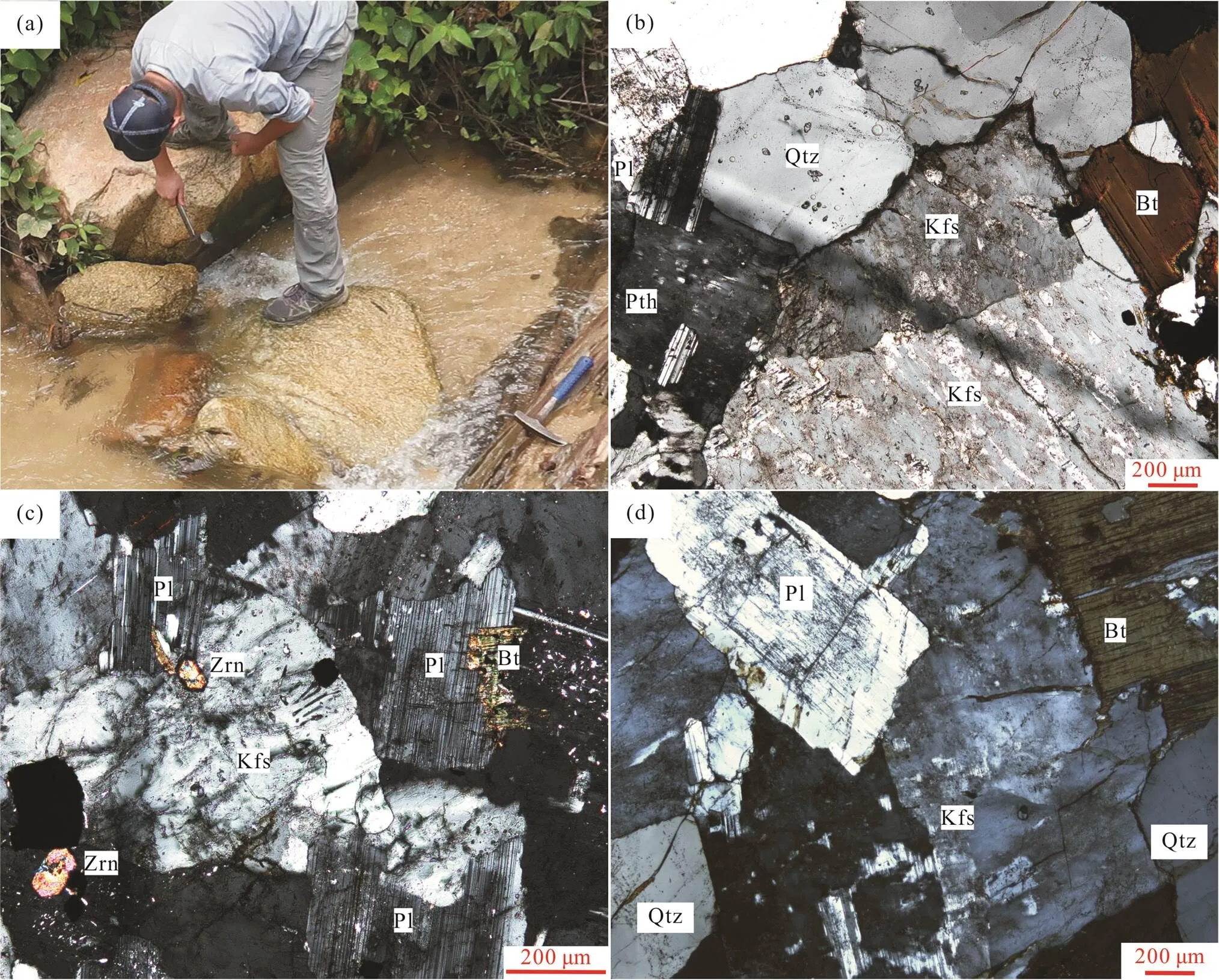
矿物代号: Qtz. 石英; Pl. 斜长石; Bt. 黑云母; Kfs. 钾长石; Pth.条纹长石; Zrn. 锆石。
3 分析结果
3.1 锆石U-Pb年龄及Hf同位素特征
样品18SM-40-1的30颗锆石U-Pb测试结果见表1。CL图像表明锆石具有弱的振荡环带(图3), 锆石的Th/U值在0.19~0.34之间, 平均为0.25。所测锆石点谐和度较好, 样品点均落在谐和线上, 其206Pb/238U加权平均年龄为55.5±0.3 Ma(2σ, MSWD= 0.87,=30; 图4)。在锆石U-Pb测试的相同位置点上进行了原位的Hf同位素分析(表2), 所获得的176Lu/177Hf 值为0.003195~0.006121,176Hf/177Hf 值为0.282486~0.282671, 对应的Hf()值为−9.1~−2.6, 二阶模式年龄(DM2)为1.29~1.70 Ga。样品落入滇西东盈江和南缅甸始新世花岗岩的Hf同位素组成区域内(图4c; Xu et al., 2012; Li et al., 2019)。
3.2 岩石地球化学特征
Panti花岗岩样品主量、微量元素测试结果见表3。样品烧失量(LOI)均小于0.6%(0.34%~0.54%), 具有高SiO2(76.61%~78.37%)含量, 其CaO(0.26%~0.39%), Fe2O3(1.21%~1.54%), MgO(0.03%~0.05%), TiO2(0.08%~ 0.1%)和P2O5(0.01%~0.02%)含量均较低。样品CIPW标准化矿物含石英(37%~44%), 正长石(26%~33%), 钠长石(20%~32%), 钙长石(1%~2%)和刚玉(1%~1.3%)。通过标准矿物在QAP三角图解投点(图5a), 样品均落在二长花岗岩区域。其铝饱和指数A/CNK值为1.08~1.12, A/NK值为1.14~1.18。在A/NK-A/CNK图解中, 均显示过铝质的特征(图5b)。样品全碱含量较高(K2O+Na2O=7.47%~8.21%), 并具高K2O/Na2O (1.18~2.21)值, 在K2O-SiO2图解中, 落入高钾钙碱性系列(图5c)。总体上样品主量元素特征与滇西和南缅甸始新世花岗岩类似(图5; 赵少伟等, 2017; Li et al., 2019),分异指数DI(DI=Q+Or+Ab+Ne+Lc+Kp)值较高, 为95~96, 表明Panti花岗岩具有高分异的特征。
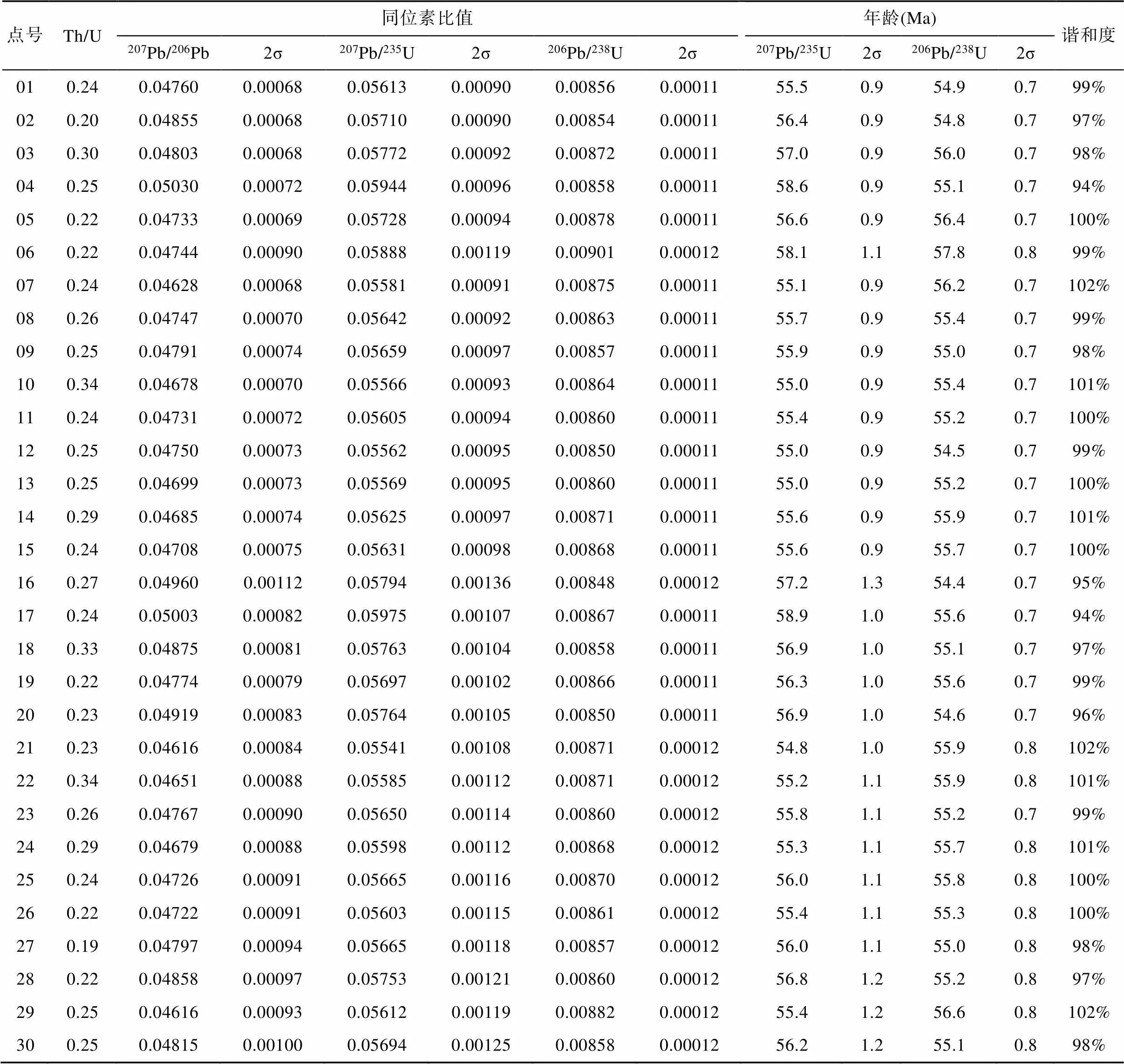
表1 Panti花岗岩(18SM-40-1) LA-ICP-MS锆石测试分析结果
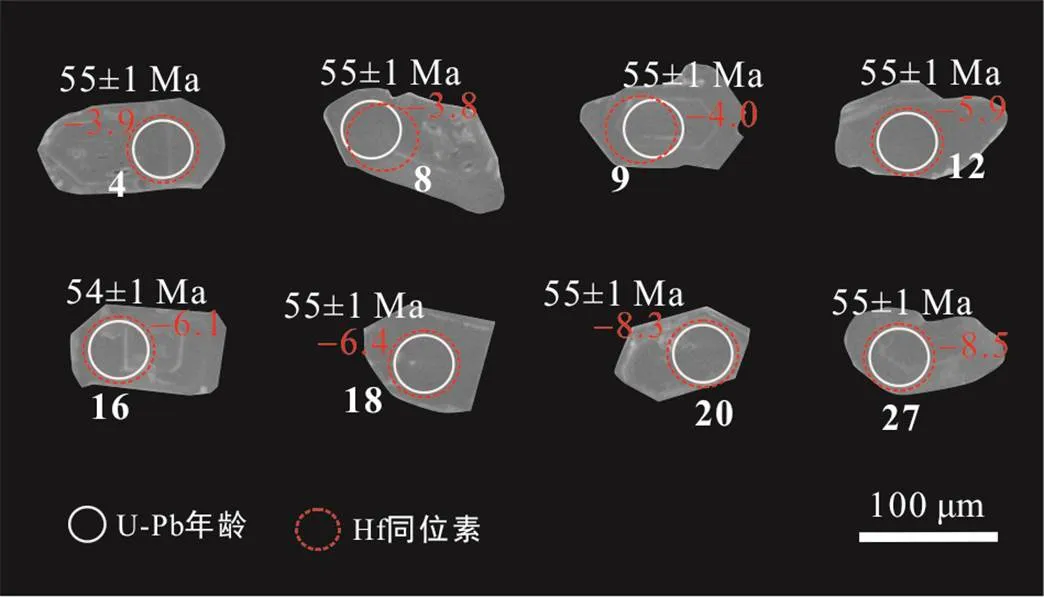
图3 Panti花岗岩样品代表性锆石颗粒的阴极发光图像
Panti花岗岩稀土元素总量(ΣREE)为160×10−6~342×10−6。在球粒陨石标准化稀土元素配分图解上(图6a)显示轻稀土元素富集, 重稀土元素亏损的右倾型模式, (La/Yb)N为6.05~20.79, (Gd/Yb)N为1.46~2.51, 且具强烈的Eu负异常(Eu/Eu*=0.04~0.05)。在原始地幔标准化的微量元素蛛网图中(图6b), 样品显示富集大离子亲石元素Rb、U和K, 而亏损高场强元素Nb、Ta和Ti的特征, 同时可见明显的Sr负异常, 且样品显示高Rb/Sr和低K/Rb值的高分异特征。此外, 样品Nb/Ta值为10~13(<5); 稀土元素四分组强度TE1, 3为0.97~1.02(<1.1), 应该是无流体相的单一体系下花岗质岩浆正常分异结晶形成的高分异花岗岩(陶继华等, 2013; Ballouard et al., 2016)。稀土元素配分模式和微量元素蛛网图显示Panti花岗岩与滇西和南缅甸始新世花岗岩特征类似(赵少伟等, 2017; Li et al., 2019)。

图c中数据来源: 苏门答腊据Zhang et al. (2019); 滇西东盈江据Xu et al. (2012); 南缅甸据Li et al. (2019); 冈底斯带亲缘、北岩浆带亲缘据Zhang et al. (2017)。
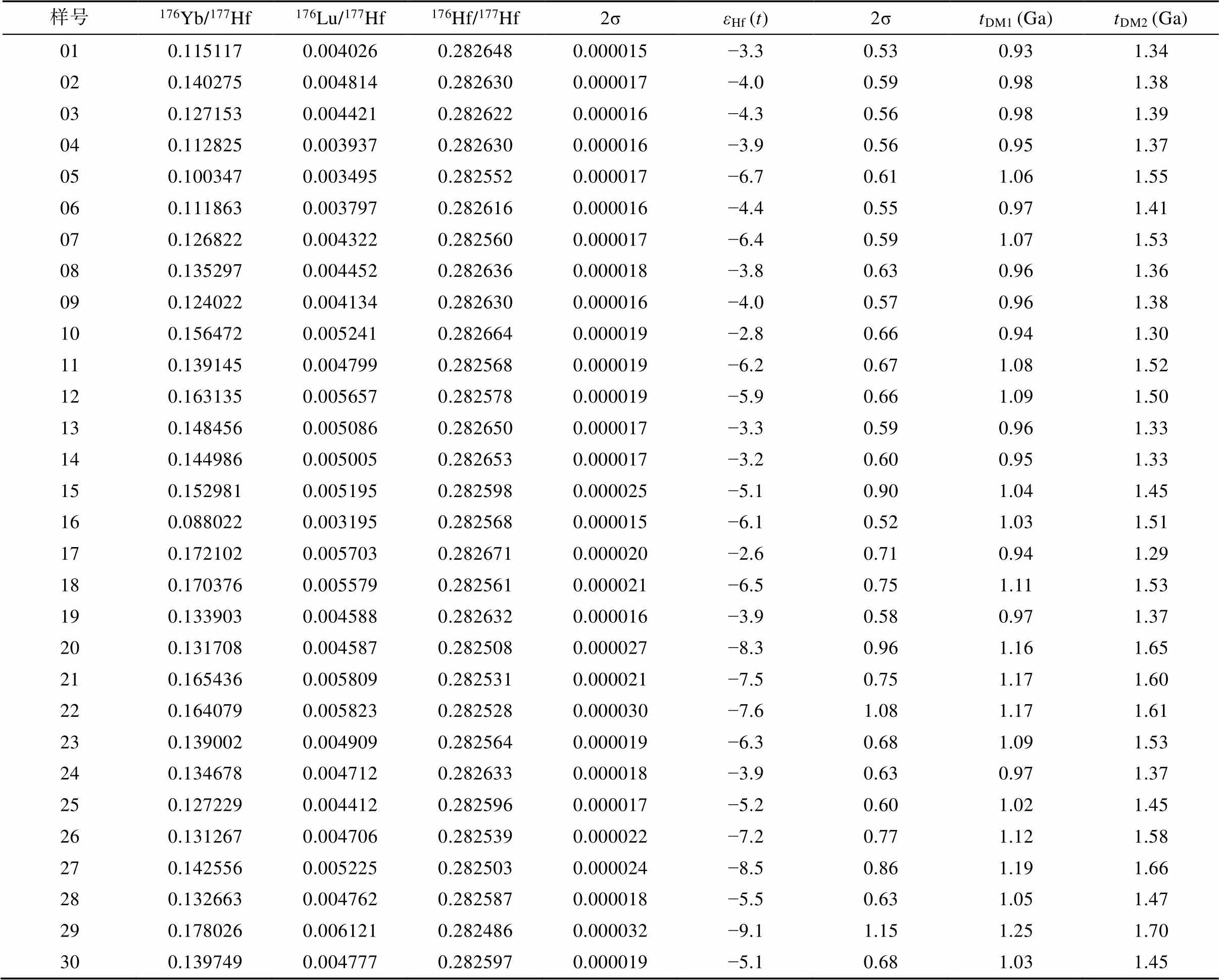
表2 Panti花岗岩(18SM-40-1)锆石Hf同位素分析结果
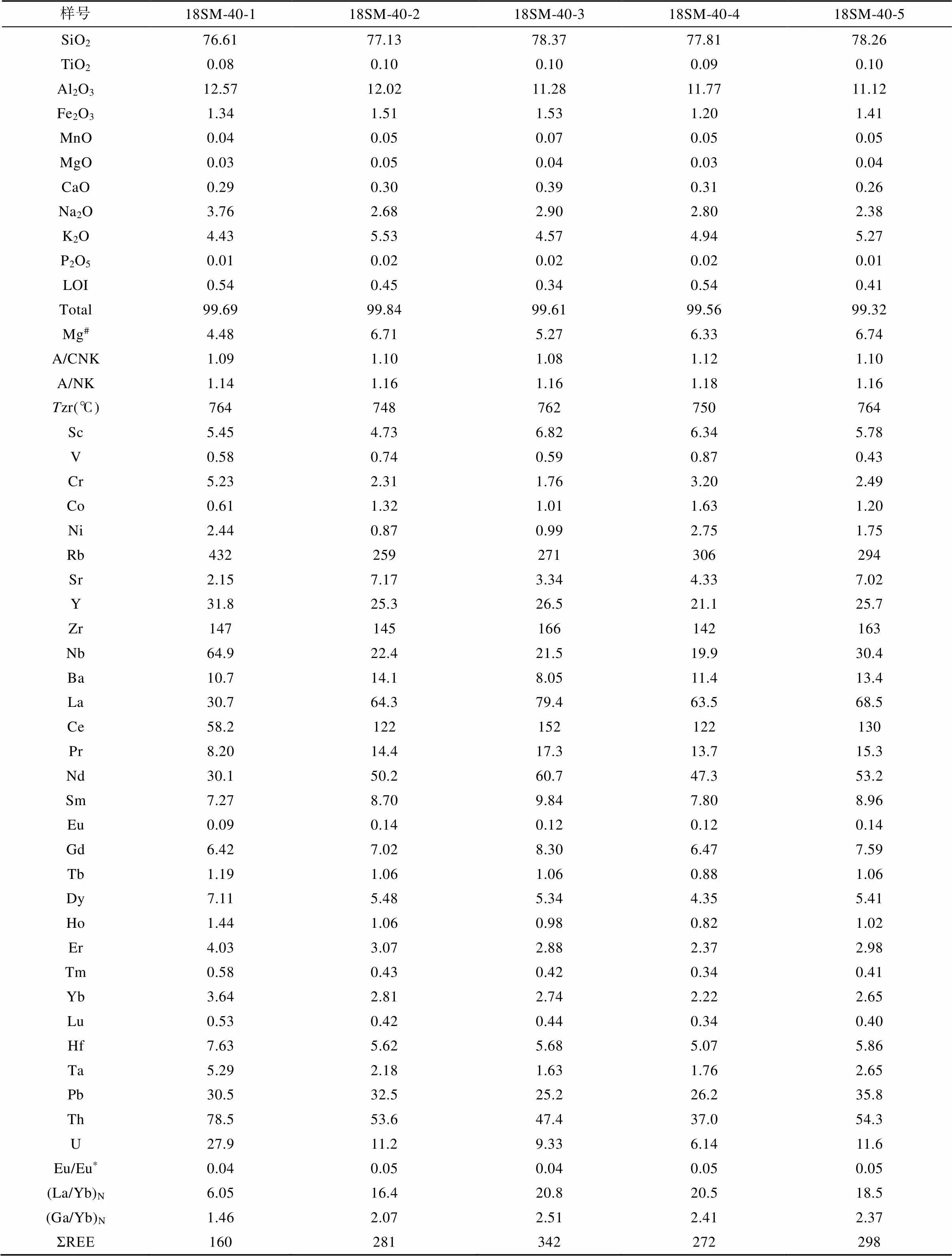
表3 Panti花岗岩主量(%)和微量元素(×10−6)组成
注: A/CNK=Al2O3/(CaO+Na2O+K2O); A/NK= Al2O3/(Na2O+K2O)。

图5 Panti花岗岩的QAP (a)、A/NK-A/CNK (b)和K2O-SiO2 (c)图解
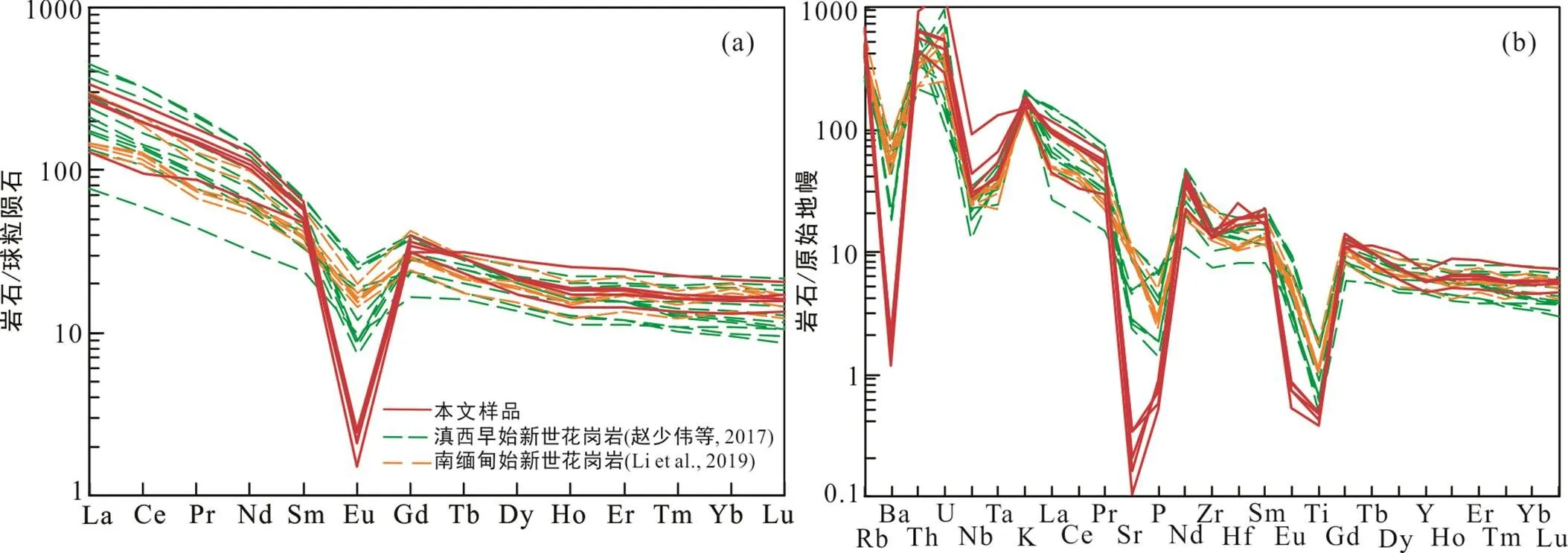
图6 Panti花岗岩球粒陨石标准化稀土元素配分曲线(a)和原始地幔标准化微量元素蛛网图(b)(球粒陨石和原始地幔标准化数据引自Sun and McDonough, 1989)
4 讨 论
4.1 岩石成因
Panti花岗岩具有较低的Ga、Zr、Nb等高场强元素组成, 其10000×Ga/Al为1.87~2.44, Zr含量为142×10−6~166×10−6, Zr+Nb+Ce+Y平均含量为327×10−6, 均低于Whalen et al. (1987)提出的A型花岗岩的元素含量(10000×Ga/Al>2.6; Zr>250×10−6; Zr+Nb+Ce+Y>350×10−6; Whalen et al., 1987), 而落入I、M、S型花岗岩区内(图7a、b)。通过全岩主量元素及Zr含量, 计算得到样品的锆石饱和温度为746~764 ℃(Boehnke et al., 2013), 均低于A型和I型花岗岩的平均锆石饱和温度(A型为839 ℃, I型为781 ℃; 据King et al., 1997)。研究认为在准铝质到弱过铝质岩浆中, 磷灰石的溶解度很低, 并在岩浆分异过程中随 SiO2的增加而降低; 而在强过铝质岩浆中, 磷灰石溶解度变化趋势与此相反(Wolf and London, 1994)。此外, 由于沉积岩因地表风化而使得Ca含量降低, 这也会抑制磷灰石的结晶, 所以有研究者认为随结晶分异作用进行, P2O5-SiO2相关关系依旧是判别I型和S型花岗岩的重要指标(陶继华等, 2013)。Panti花岗岩显示弱‒强过铝质的特征, 其P2O5随着SiO2含量增加而递增(图7c), 该特征与S型花岗岩的演化趋势相类似。结合其高分异的特征, 认为Panti花岗岩为高分异的S型花岗岩。
在稀土元素配分图中(图6a), Panti花岗岩样品显示明显的Eu负异常, Rb/Ba值与Eu/Eu*呈明显的负相关关系(图8a), 指示其形成过程中存在斜长石的分离结晶作用。Panti花岗岩具有明显Ba和Eu的亏损(图6), 结合Ba-Sr和Rb-Sr图解(图8b、c), 显示该套花岗岩岩浆在演化过程中存在斜长石和钾长石的分离结晶作用。此外, 微量元素蛛网图中样品具有明显P和Ti负异常(图6b), 这可能与磷灰石及含钛矿物的分离结晶有关。
一般认为强过铝质花岗岩主要由变沉积岩部分熔融形成(Koester et al., 2002; Jiang et al., 2011)。Panti花岗岩样品具有低Sr(2.15×10−6~7.17×10−6)、Ba(8.05×10−6~14.1×10−6)和高Rb(259×10−6~432×10−6)含量的特征, 表明其源区可能为富云母的变沉积岩(Zen, 1986)。Zeng et al. (2011)认为变泥质岩的云母脱水熔融可以产生具有低Sr、Ba和高Rb/Sr值的花岗质岩浆(Zeng et al., 2011)。变泥质岩派生的花岗岩熔体比变砂屑岩派生的花岗岩熔体具有更低的CaO/Na2O值(<0.3; Sylvester, 1998; Jung and Pfänder, 2007)。且样品CaO/Na2O值很低(0.08~0.13), 且具高的Al2O3/TiO2和Al2O3/(MgO+FeOt)值特征(图9), 与变泥质岩派生的熔体一致。由于泥质岩白云母部分熔融程度较低, 在蒸气相条件下白云母部分熔融形成的熔体具有Rb和Sr富集的特征; 无蒸气相条件下白云母部分熔融程度更低, 且源区会有大量长石残留, 这与Panti花岗岩样品Rb/Ba值与Eu/Eu*呈明显负相关的特征不符, 所以推测Panti花岗岩不是泥质岩的低程度部分熔融形成。在蒸气相条件下, 泥质岩黑云母部分熔融, 需要高熔点且部分熔融程度很高(F>0.6); 无蒸气相条件下, 泥质岩中白云母和黑云母均发生部分熔融时, 部分熔融程度增大, 达=0.28, 形成Rb富集, Sr和Ba含量降低的熔体(Harris and Ingcr, 1991)。且随着黑云母的熔融, 熔体的Rb含量更加富集, 这与本次研究样品富集Rb、亏损Sr和Ba特征一致。另外该花岗岩锆石Hf()为−9.1~−2.6, 类似滇西东盈江和南缅甸地区的S型花岗岩特征(图4c), 说明其源区主要为变沉积物, 且幔源物质的参与不明显。综合以上分析, Panti花岗岩是由富泥质的变沉积岩较高程度的部分熔融后, 经斜长石和钾长石的分离结晶作用而形成的。
4.2 区域岩浆对比及构造背景探讨
中生代, 新特提斯洋的俯冲及随后印度板块与欧亚板块碰撞, 在藏南、滇西、缅甸等地区形成了巨型的特提斯构造岩浆岩带, 该岩浆岩带上广泛分布有始新世花岗岩。特提斯岩浆带被认为可以从藏南拉萨地块(Ji et al., 2012; Lee et al., 2012)延伸至藏东南波密‒察隅地区(Lin et al., 2012), 经滇西腾梁‒盈江地区(杨启军等, 2009; Ma et al., 2014), 向南延伸至缅甸的抹谷变质带(Bertrand et al., 1999, 2001; Barley et al., 2003; Mitchell et al., 2007; Searle et al., 2007; Mitchell et al., 2012)。前人研究认为白垩纪‒早始新世(120~50 Ma), 自巴基斯坦、印度、中国西藏和尼泊尔的喜马拉雅岩基经缅甸至苏门答腊岛发育有近200 km宽、与俯冲相关的大型花岗岩岩浆带(Mitchell, 1993; Barley et al., 2003)。最近Zhang et al. (2019)通过碎屑锆石年龄对比认为从藏南至苏门答腊岛存在约6000 km的新特提斯弧系统, 其中苏门答腊岛发育有~52 Ma的弧岩浆期次, 为新特提斯洋俯冲的产物。此外Katili (1973)通过K/Ar定年发现Panti东部及其西边的Sontang地区分别出露42.7 Ma和47.7 Ma花岗闪长岩, 认为该区也存在始新世岩浆事件。结合区域已报道的与新特提斯洋有关的岩浆岩年龄数据(图10), 我们认为苏门答腊岛中部Panti花岗岩可以与藏南冈底斯、滇西和缅甸的火成岩年龄进行对比, 证明特提斯岩浆带从藏南经云南西部及缅甸, 向南可以延伸至苏门答腊岛内。

图7 Panti花岗岩(K2O+Na2O)/CaO-(Zr+Nb+Ce+Y)(a)、Zr-10000×Ga/Al(b)和P2O5-SiO2(c)判别图解(图a、b据Whalen et al., 1987)

图8 Panti花岗岩Eu/Eu*-Rb/Ba(a)、Ba-Sr(b)和Rb-Sr(c)图解
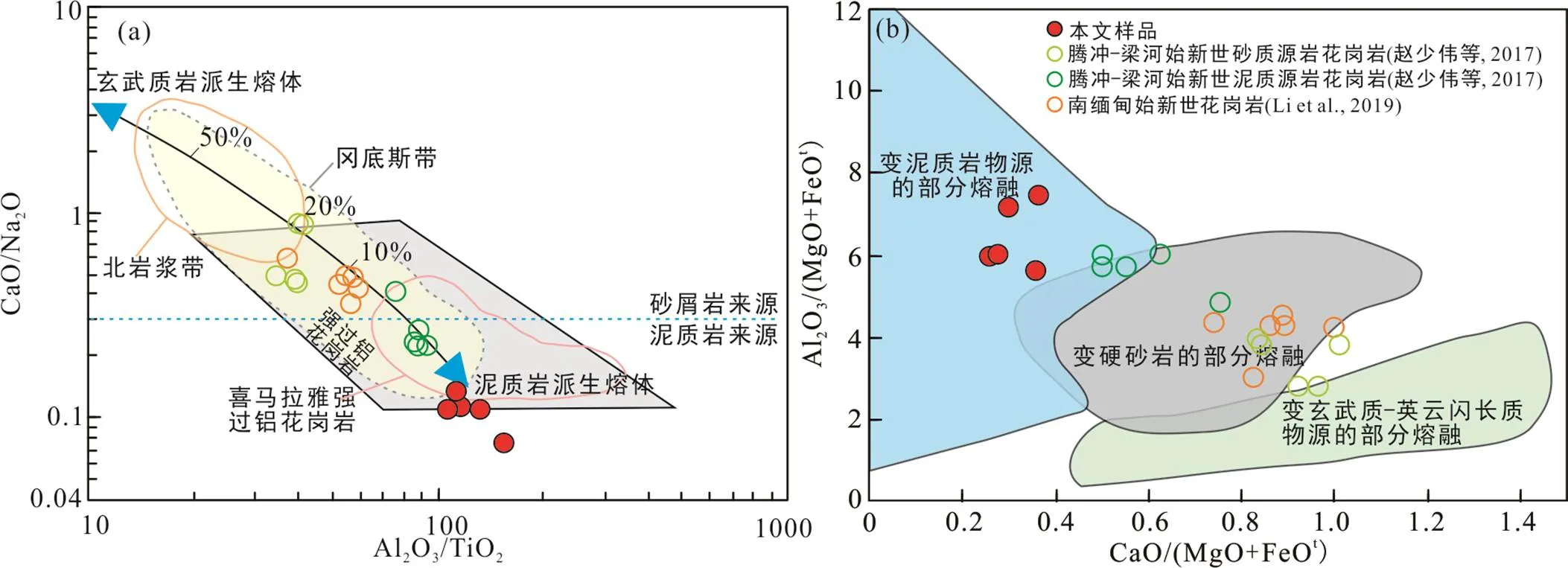
图9 Panti花岗岩CaO/Na2O-Al2O3/TiO2(a)和Al2O3/(MgO+FeOt)-CaO/(MgO+FeOt)(b)岩浆源区来源判别图(a和b底图据Ma et al., 2014)
对于印度板块与欧亚板块碰撞的时间从晚白垩世(~70 Ma; Yin and Harrison, 2000; ~65 Ma; Ding et al., 2005)到晚渐新世(~34 Ma; Aitchison et al., 2007)尚未有定论, 但目前主流观点认为印度板块与欧亚板块主碰撞时间约为50~55 Ma(Klootwijk et al., 1992; 朱弟成等, 2004; Leech et al., 2005; Garzanti, 2008; Wu et al., 2008; Najman et al., 2010; Wang et al., 2011; Zhu et al., 2015)。在藏南拉萨地块包括冈底斯岩基和林子宗群上分布41~65 Ma I型花岗岩, 被认为是下地壳底侵重熔的产物, 并有幔源物质的贡献(Ji et al., 2009, 2012; 李洪梁等, 2019), 即该区存在岩浆底侵和岩浆混合作用(黄玉等, 2010; 阮冰等, 2019)。并且藏南地区至少从51 Ma起, 特提斯洋消减后, 发生新生玄武岩底侵地壳加厚作用, 并随着俯冲作用的进行, 从活动大陆边缘向陆内地壳物质贡献逐渐增多(Ji et al., 2012)。在滇西地区, Wang et al. (2014)和Ma et al. (2014)则认为约50~55 Ma是新特提斯洋俯冲向印度板块与欧亚板块陆陆碰撞的转换时间, 并随着远离俯冲带, 从西向东幔源物质贡献越来越少, 西部表现为有新生地壳参与的I型花岗岩为主(Ma et al., 2014); 而东部腾梁及东盈江地区则以壳源物质部分熔融具负Hf()值的S型花岗岩为主; 而在缅甸地区, 西侧靠近俯冲带的西缅甸始新世花岗岩是具有正Hf()值(1.3~16.5)的I型花岗岩, 被认为是新生地壳物质和古老俯冲沉积物混合的弧岩浆岩(Zhang et al., 2017)。东部南缅甸包括抹谷变质带, 始新世花岗岩是以负Hf()和Nd()为特征的S型花岗岩为主(Zaw, 1990; Mitchell et al., 2012; Jiang et al., 2017), 被认为是由于新特提斯洋俯冲, 古老的滇缅马苏地壳衍生而来(Li et al., 2019)。
一直以来对于地处在特提斯构造域的苏门答腊岛的研究相对较薄弱。最近Advokaat et al. (2018)通过古地磁数据认为, 特提斯洋闭合记录可能保存在Woyla地体向北延伸的西缅甸(Liu et al., 2016)和安得曼群岛的蛇绿岩中(Sarma et al., 2010); 周蒂等(2003)通过区域地层对比, 认为Woyla地体是藏南拉萨地块班公‒怒江特提斯带向南的延伸; Zhang et al., (2019)通过对苏门答腊岛碎屑锆石年龄谱系及Hf同位素区域对比, 认为该区始新世岩浆岩是藏南冈底斯岩基的南延, 均为新特提斯洋俯冲的产物, 并源于新生地壳。本次研究表明, Panti始新世花岗岩是由富泥质变沉积岩的部分熔融而形成的, 与其北延的滇西腾梁(赵少伟等, 2017)、盈江东部(Xu et al., 2012)及南缅甸(Li et al., 2019)地区同时期与俯冲相关的S型花岗岩相似。此外, 该花岗岩与新特提斯构造演化有关的东盈江和南缅甸始新世花岗岩、苏门答腊新特提斯弧系统的始新世岩浆锆石的Hf同位素组成相似(图4c; Xu et al., 2012; Li et al., 2019; Zhang et al., 2019)。Khan et al. (2017)认为自晚中生代开始, 苏门答腊沿巺他海沟一直受新特提斯洋的俯冲作用, 并在晚始新世至早渐新世期间, 发育相应的弧后扩张盆地(Barber et al., 2005)。McCourt et al. (1996)认为60~50 Ma, 苏门答腊大陆边缘存在一个岛弧体系, 并形成广布的火山弧型花岗岩, 其中57~52 Ma I型和S型花岗岩可延伸至缅甸境内(Cobbing et al., 1992; Mitchell, 1993)。此外, 在Rb-Hf-Ta和Ta-Yb的构造判别图解中, Panti花岗岩样品和新特提斯岩浆带上的腾梁、盈江和缅甸地区同时期的花岗岩均落在火山弧花岗岩中(图11; Ma et al., 2014; 赵少伟等, 2017; Li et al., 2019)。因此, 我们认为Panti花岗岩应该是俯冲构造背景下形成的。综合研究表明Panti花岗岩与腾梁和东盈江花岗岩特征相似,为新特提斯洋俯冲过程中的产物, 证明新特提斯构造岩浆带可从藏南经滇西南延至苏门答腊中部。结合该区新特提斯洋俯冲形成的岩浆期次(Zhang et al., 2019), 表明~55 Ma苏门答腊岛地区新特提斯洋尚未关闭。
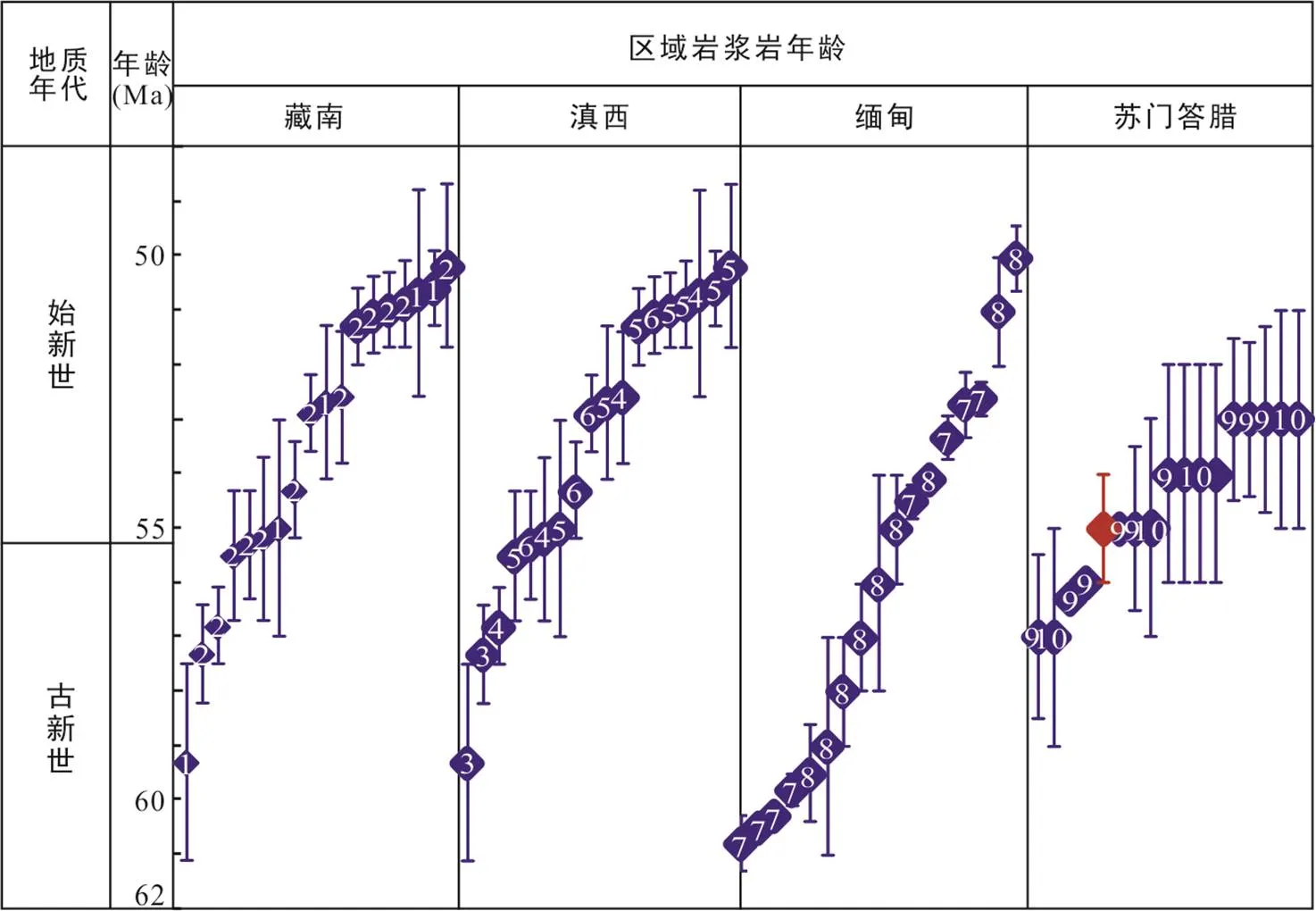
数据来源: 藏南: (1) Wen et al. (2008); (2) Ji et al. (2009); 滇西: (3) Liang et al. (2008); (4) Xu et al. (2012); (5) Ma et al. (2014); (6) Wang et al. (2014); 缅甸: (7) Li et al. (2019); (8) Crow et al. (2017); 苏门答腊: (9) Cobbing (2005); (10) McCourt et al. (1996); 红色为本文样品。
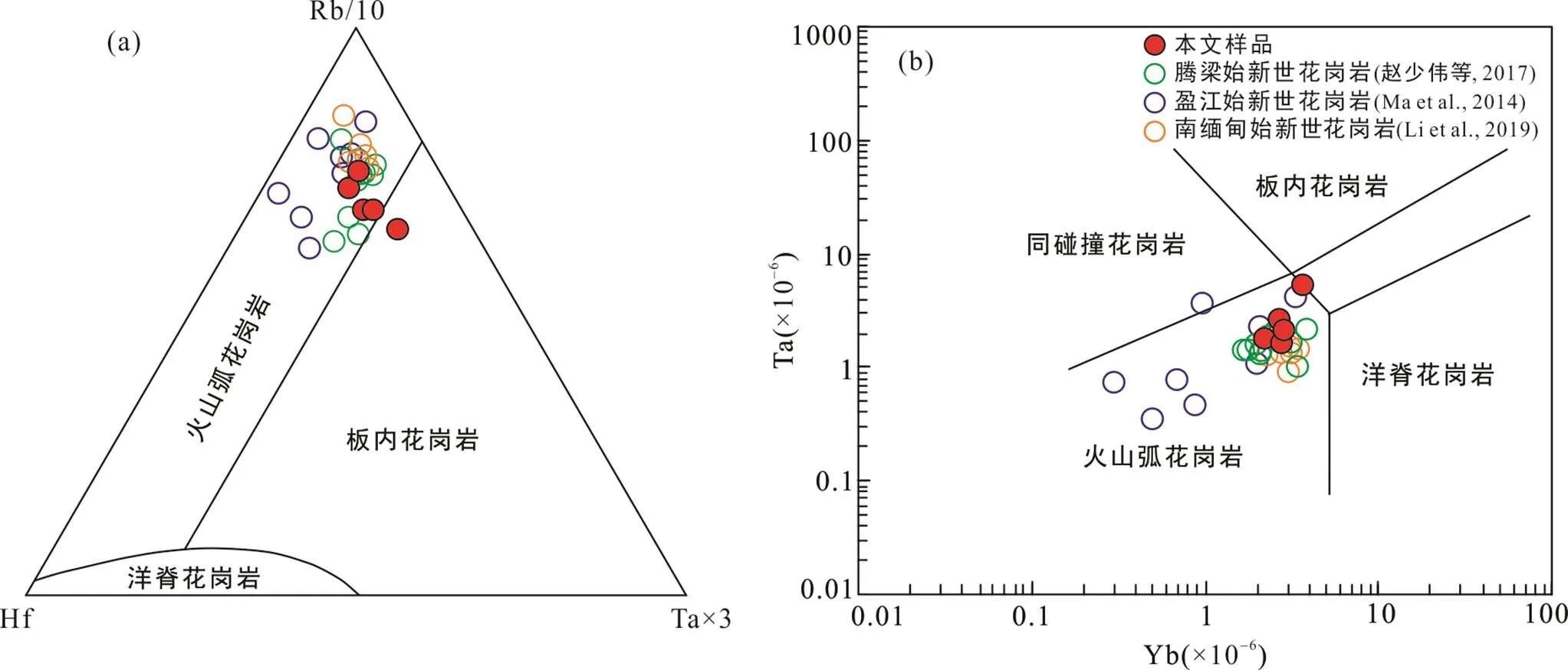
图11 Panti花岗岩构造背景判别图解(a据Harris et al., 1986; b据Pearce et al., 1984)
5 结 论
(1) 苏门答腊岛中部Panti地区识别出了早始新世花岗岩, 其锆石U-Pb年龄为55.5±0.3 Ma(2σ, MSWD=0.87,=30)。
(2) Panti花岗岩为过铝质的高分异S型花岗岩, 其Hf()为−9.1~−2.6, 二阶模式年龄为1.29~1.70 Ga, 地球化学研究表明该套花岗岩为富泥质变沉积岩部分熔融的产物。
(3) Panti花岗岩可以与藏南冈底斯、滇西和缅甸地区的同期花岗岩对比和联系, 证明了新特提斯洋构造岩浆带可以向南延伸至苏门答腊岛Panti地区。
致谢:野外样品采集过程中得到了广州海洋地质调查局张立敏博士的帮助, 实验分析中得到了中山大学甘成势、王玉琨和杨雪博士的帮助, 在此一并致以衷心的感谢。感谢中国地质大学(武汉)徐亚军教授和另一位匿名审稿专家对该论文提出宝贵的修改意见。
Claisse F and Blanchette J S. 2006. 硼酸盐熔融的物理与化学: 献给X射线荧光光谱学工作者. 上海: 华东理工大学出版社: 1–108.
黄玉, 赵志丹, 张凤琴, 朱弟成, 董国臣, 周肃, 莫宣学. 2010. 西藏冈底斯仁布‒拉萨一带花岗岩基的地球化学及其意义. 岩石学报, 26(10): 3131–3142.
李洪梁, 李光明, 刘洪, 黄瀚霄, 曹华文, 代作文. 2019. 拉萨地体西段达若地区古新世花岗斑岩成因: 锆石U-Pb年代学、岩石地球化学和Sr-Nd-Pb-Hf同位素的约束. 地球科学, 44(7): 2275–2294.
马莉燕. 2013. 滇西盈江地区始新世早期岩浆作用成因与构造意义. 广州: 中国科学院广州地球化学研究所博士学位论文: 1–87.
马莉燕, 范蔚茗, 王岳军, 蔡永丰, 刘汇川. 2013. 那邦地区花岗片麻岩的锆石U-Pb年代学及Hf同位素组成特征. 大地构造与成矿学, 37(2): 273–283.
阮冰, 骆必继, 张宏飞, 郭亮, 徐旺春, 赵新福, 张文, 郭京梁. 2019. 西藏冈底斯带始新世曲水岩基的岩浆混合作用: 来自斜长石阴极发光特征和成分变化的证据. 地球科学, 44(6): 1834–1848.
陶继华, 李武显, 李献华, 岑涛. 2013. 赣南龙源坝地区燕山期高分异花岗岩年代学、地球化学及锆石Hf-O同位素研究. 中国科学: 地球科学, 43(5): 760–778.
杨启军, 徐义刚, 黄小龙, 罗震宇, 石玉若. 2009. 滇西腾冲‒梁河地区花岗岩的年代学、地球化学及其构造意义. 岩石学报, 25(5): 86–98.
赵少伟, 赖绍聪, 秦江锋, 朱韧之, 甘保平. 2017. 腾冲地块梁河早始新世花岗岩成因机制及其地质意义. 岩石学报, 33(1): 191–203.
周蒂, 颜佳新, 丘元禧, 陈汉宗, 孙珍. 2003. 南海西部围区中特提斯东延通道问题. 地学前缘, 10(4): 469–477.
朱弟成, 潘桂棠, 莫宣学, 段丽萍, 廖忠礼. 2004. 印度大陆和欧亚大陆的碰撞时代. 地球科学进展, 19(4): 564–571.
朱弟成, 潘桂棠, 王立全, 莫宣学, 赵志丹, 周长勇, 廖忠礼, 董国臣, 袁四化. 2008. 西藏冈底斯带中生代岩浆岩的时空分布和相关问题的讨论. 地质通报, 27(9): 1535–1550.
Advokaat E L, Bongers M L M, Rudyawan A, BouDagher- Fadel M K, Langereis C G and van Hinsbergen D J J. 2018. Early Cretaceous origin of the Woyla Arc (Sumatra, Indonesia) on the Australian plate., 487: 151–164.
Aitchison J C, Ali J R and Davis A M. 2007. When and where did India and Asia collide?, 112B: B05423.
Ballouard C, Poujol M, Boulvais P, Branquet Y, Tartèse R and Vigneresse J L. 2016. Nb-Ta fractionation in peraluminous granites: A marker of the magmatic hydrothermal transition., 44(3): 231–234.
Barber A J. 2000. The origin of the Woyla terranes in Sumatra and the Late Mesozoic evolution of the Sundaland margin., 18(6): 713–738.
Barber A J and Crow M J. 2003. An evaluation of plate tectonic models for the development of Sumatra., 6(1): 1–28.
Barber A J and Crow M J. 2008. The origin and emplacement of the West Burma-West Sumatra ribbon-continent, Proceedings of the International Symposia on GeoscienceResources and Environments of Asian Terranes (GREAT 2008), 4th IGCP.: 24–26.
Barber A J and Crow M J. 2009. Structure of Sumatra and its implications for the tectonic assembly of Southeast Asia and the destruction of Paleotethys., 18(1): 3–20.
Barber A J, Crow M J and De Smet M E M. 2005. Chapter 14: Tectonic evolution // Barber A J, Crow M J and Milsom J S. Sumatra: Geology, Resources and Tectonic Evolution.,,, 31: 234–259.
Barley M E, Pickard A L, Zaw K, Rak P and Doyle M G. 2003. Jurassic to Miocene magmatism and metamorphism in the Mogok metamorphic belt and the India-Eurasia collision in Myanmar., 22(3), https: //doi.org/ 10.1029/2002TC001398.
Bertrand G, Rangin C, Maluski H, Bellon H and Party G S. 2001. Diachronous cooling along the Mogok MetamorphicBelt (Shan scarp, Myanmar): The trace of the northwardmigration of the Indian syntaxis., 19(5): 649–659.
Bertrand G, Rangin C, Maluski H, Han T A, Thein M, Myint O, Maw W and Lwin S. 1999. Cenozoic metamorphism along the Shan scarp (Myanmar): Evidences for ductile shear along the Sagaing fault or the northward migration of the eastern Himalayan syntaxis?, 26(7): 915–918.
Boehnke P, Watson E B, Trail D, Harrison T M and Schmitt A K. 2013. Zircon saturation re-revisited., 351: 324–334.
Cameron N R, Clarke M C G, Aldiss D T, Aspden J A and Djunuddin A. 1980. The geological evolution of northernSumatra.,9th,: 149–187.
Chu M F, Chung S L, Song B A, Liu D Y, O’Reilly S Y, Pearson N J, Ji J Q and Wen D J. 2006. Zircon U-Pb and Hf isotope constraints on the Mesozoic tectonics and crustal evolution of southern Tibet., 34(9): 745–748.
Chung S L, Chu M F, Zhang Y Q, Xie Y W, Lo C H, Lee T Y, Lan C Y, Li X H, Zhang Q and Wang Y Z. 2005. Tibetan tectonic evolution inferred from spatial and temporal variations in post-collisional magmatism., 68(3–4): 173–196.
Cobbing E J. 2005. Chapter 5: Granites // Barber A J, Crow M J and Milsom J S. Sumatra: Geology, Resources and Tectonic Evolution.,,, 31: 54–62.
Cobbing E J, Pitfield P E J, Darbyshire D P F and Mallick D I J. 1992. The granites of the Southeast Asian tin belt.,: 10.
Crow M J and Khin Z. 2017. Appendix Geochronology in Myanmar (1964–2017).,,, 48(1): 713–759.
Ding L, Kapp P and Wan X Q. 2005. Paleocene-Eocene record of ophiolite obduction and initial India-Asia collision, south central Tibet.: 24(3), TC3001.
Garzanti E. 2008. Comment on “When and where did India and Asia collide?” by Jonathan C. Aitchison, Jason R. Ali, and Aileen M. Davis., 113(B4), B04411.
Griffin W L, Pearson N J, Belousova E, Jackson S E, van Achterbergh E, O’Reilly S Y and Shee S R. 2000. The Hf isotope composition of cratonic mantle: LAM-MC- ICPMS analysis of zircon megacrysts in kimberlites., 64(1): 133–147.
Griffin W L, Powell W J, Pearson N J and O’Reilly S Y. 2008. GLITTER: Data reduction software for laser ablation ICP-MS // Sylvester P. Laser Ablation-ICP-MS in the Earth Sciences., 40: 204–207.
Griffin W L, Wang X, Jackson S E, Pearson N J, O’Reilly S Y, Xu X S and Zhou X M. 2002. Zircon chemistry and magma mixing, SE China:analysis of Hf isotopes, Tonglu and Pingtan igneous complexes., 61(3–4): 237–269.
Hall R. 2012. Late Jurassic-Cenozoic reconstructions of the Indonesian region and the Indian Ocean., 570–571: 1–41.
Hamilton W B, 1979. Tectonics of the Indonesian region. Washington: United States Government Printing Office: 1–345.
Harris N B W and Ingcr S. 1991. Trace element modelling of pelite-derived granites., 110: 46–56.
Harris N B W, Pearce J A and Tindle A G. 1986. Geochemical characteristics of collision zone magmatism.,,, 19: 67–81.
Hu Z C, Liu Y S, Gao S, Liu W G, Zhang W, Tong X R, Lin L, Zong K Q, Li M, Chen H H, Zhou L and Yang L. 2012. ImprovedHf isotope ratio analysis of zircon using newly designed X skimmer cone and jet sample cone in combination with the addition of nitrogen by laser ablation multiple collector ICP-MS., 27(9): 1391– 1399.
Ji W Q, Wu F Y, Chung S L, Li J X and Liu C Z. 2009. Zircon U-Pb geochronology and Hf isotopic constraints on petrogenesis of the Gangdese batholith, southern Tibet., 262(3–4): 229–245.
Ji W Q, Wu F Y, Liu C Z and Chung S L. 2012. Early Eocene crustal thickening in southern Tibet: New age and geochemical constraints from the Gangdese batholith., 53: 82–95.
Jiang H, Li W Q, Jiang S Y, Wang H and Wei X P. 2017. Geochronological, geochemical and Sr-Nd-Hf isotopic constraints on the petrogenesis of Late Cretaceous A-type granites from the Sibumasu Block, Southern Myanmar, SE Asia., 268: 32–47.
Jiang Y H, Zhao P, Zhou Q, Liao S Y and Jin G D. 2011. Petrogenesis and tectonic implications of Early Cretaceous S- and A-type granites in the northwest of the Gan-Hang rift, SE China., 121(1–4): 55–73.
Jung S and Pfander J A. 2007. Source composition and melting temperatures of orogenic granitoids: Constraints from CaO/Na2O, Al2O3/TiO2and accessory mineral saturation thermometry., 19(6): 859–870.
Katili J A. 1973. Geochronology of West Indonesia and its implication on plate tectonics., 19(3): 195–212.
Khan P K, Shamim S, Mohanty M, Kumar P and Banerjee J. 2017. Myanmar-Andaman-Sumatra subduction margin revisited: Insights of arc-specific deformations., 28(4): 683–694.
King P L, White A J R, Chappell B W and Allen C M. 1997. Characterization and origin of aluminous A-type granites from the Lachlan Fold Belt, southeastern Australia., 38(3): 371–391.
Klootwijk C T, Gee J S, Peirce J W, Smith G M and McFadden P L. 1992. An early India-Asia contact: Paleomagnetic constraints from Ninetyeast Ridge, ODP Leg 121., 20: 395–398.
Koester E, Pawley A R, Fernandes L A D, Porcher C C and Soliani E. 2002. Experimental melting of cordierite gneiss and the petrogenesis of syntranscurrent peraluminous granites in southern Brazil., 43(8): 1595–1616.
Lee H Y, Chung S L, Ji J, Qian Q, Gallet S, Lo C H, Lee T Y and Zhang Q. 2012. Geochemical and Sr-Nd isotopic constraints on the genesis of the Cenozoic Linzizong volcanic successions, southern Tibet., 53: 96–114.
Leech M L, Singh S, Jain A, Klemperer S L and Manickavasagam R. 2005. The onset of India-Asia continental collision: Early, steep subduction required by the timing of UHP metamorphism in the western Himalaya., 234(1–2): 83–97.
Li J X, Fan W M, Zhang L Y, Evans N J, Sun Y L, Ding L, Guan Q Y, Peng T P, Cai F L and Sein K. 2019. Geochronology, geochemistry and Sr-Nd-Hf isotopic compositions of Late Cretaceous-Eocene granites in southern Myanmar: Petrogenetic, tectonic and metallogenic implications., 112: 1–16.
Liang Y H, Chung S L, Liu D Y, Xu Y G, Wu F Y, Yang J H, Wang Y and Lo C H. 2008. Detrital zircon evidence from Burma for reorganization of the eastern Himalayan river system., 308(4): 618–638.
Lin I J, Chung S L, Chu C H, Lee H Y, Gallet S, Wu G Y, Ji J Q and Zhang Y Q. 2012. Geochemical and Sr-Nd isotopic characteristics of Cretaceous to Paleocene granitoids and volcanic rocks, SE Tibet: Petrogenesis and tectonic implications., 53: 131– 150.
Liu C Z, Chung S L, Wu F Y, Zhang C, Xu Y, Wang J G, Chen Y and Guo S. 2016. Tethyan suturing in Southeast Asia: Zircon U-Pb and Hf-O isotopic constraints from Myanmar ophiolites., 44(4): 311–314.
Ma L Y, Wang Y J, Fan W M, Geng H Y, Cai Y F, Zhong H, Liu H C and Xing X W. 2014. Petrogenesis of the early Eocene I-type granites in west Yingjiang (SW Yunnan) and its implication for the eastern extension of the Gangdese batholiths., 25(1): 401–419.
McCourt W J, Crow M J, Cobbing E J and Amin T C. 1996. Mesozoic and Cenozoic plutonic evolution of SE Asia: evidence from Sumatra, Indonesia // Hall R and Blundell DJ. Tectonic Evolution of Southeast Asia., 106(15): 321–335.
Metcalfe I. 1993. Southeast Asian terranes: Gondwanaland origins and evolution // Findlay R H, Unrug R, Banks, M R and Veevers J J. Gondwana 8-Assembly, Evolution, and Dispersal (Proceedings Eighth Gondwana Symposium, Hobart, 1991). Rotterdam: A.A. Balkema Publishers: 181–200.
Metcalfe I. 1996. Pre-Cretaceous evolution of SE Asian terranes.,,, 106(1): 97–122.
Metcalfe I. 2011. Tectonic framework and Phanerozoic evolution of Sundaland., 19(1): 3–21.
Metcalfe I. 2013. Gondwana dispersion and Asian accretion: Tectonic and palaeogeographic evolution of eastern Tethys., 66: 1–33.
Mitchell A, Chung S L, Oo T, Lin T H and Hung C H. 2012. Zircon U-Pb ages in Myanmar: Magmatic-metamorphic events and the closure of a neo-Tethys ocean?, 56: 1–23.
Mitchell A, Htay M T, Htun K M, Win M N, Oo T and Hlaing T. 2007. Rock relationships in the Mogok metamorphic belt, Tatkon to Mandalay, central Myanmar., 29(5–6): 891–910.
Mitchell A H G. 1993. Cretaceous-Cenozoic tectonic events in the western Myanmar (Burma)-Assam region., 150: 1089–1102.
Najman Y, Appel E, Boudagher-Fadel M, Bown P, Carter A, Garzanti E, Godin L, Han J T, Liebke U, Oliver G, Parrish R and Vezzoli G. 2010. Timing of India-Asia collision: Geological, biostratigraphic, and palaeomagneticconstraints.:, 115(B12).
Pearce J A, Harris N B W and Tindle A G. 1984. Trace element discrimination diagrams for the tectonic interpretation of granitic rocks., 25(4): 956–983.
Sarma D S, Jafri S, Fletcher I R and McNaughton N J. 2010. Constraints on the tectonic setting of the Andaman ophiolites, Bay of Bengal, India, from SHRIMP U-Pb zircon geochronology of plagiogranite., 118(6): 691–697.
Searle M P, Noble S R, Cottle J M, Waters D J, Mitchell A H G, Hlaing T and Horstwood M S A. 2007. Tectonic evolution of the Mogok metamorphic belt, Burma (Myanmar) constrained by U-Th-Pb dating of metamorphic and magmatic rocks., 26(3): 1–24.
Söderlund U, Patchett P J, Vervoort J D and Isachsen C E. 2004. The176Lu decay constant determined by Lu-Hf and U-Pb isotope systematics of Precambrian mafic intrusions., 219(3–4): 311–324.
Sun S S and McDonough W F. 1989. Chemical and isotopic systematics of oceanic basalts: Implications for mantle composition and processes.,,, 42(1): 313–345.
Sylvester P J. 1998. Post-collisional strongly peraluminous granites., 45(1): 29–44.
Wajzer M R, Barber A J and Hidayat S. 1991. Accretion, collision and strike-slip faulting: The Woyla Group as a key to the tectonic evolution of North Sumatra., 6(3–4): 447–461.
Wang J G, Hu X M, Jansa L B and Huang Z C. 2011. Provenance of the Upper Cretaceous-Eocene deep-water sandstones in Sangdanlin, Southern Tibet: Constraints on the timing of initial India-Asia collision., 119(3): 293–309.
Wang J G, Wu F Y, Tan X C and Liu C Z. 2014b. Magmatic evolution of the Western Myanmar Arc documented by U-Pb and Hf isotopes in detrital zircon., 612: 97–105.
Wang Y J, Qian X, Cawood P A, Liu H C, Feng Q L, Zhao G C, Zhang Y H, He H Y and Zhang P Z. 2018. Closure of the East Paleotethyan Ocean and amalgamation of the Eastern Cimmerian and Southeast Asia continental fragments., 186: 195–230.
Wang Y J, Zhang L M, Cawood P A, Ma L Y, Fan W M, Zhang A M, Zhang Y Z and Bi X W. 2014. Eocene supra-subduction zone mafic magmatism in the SibumasuBlock of SW Yunnan: Implications for Neotethyan subduction and India-Asia collision., 206: 384–399.
Wen D R, Liu D Y, Chung S L, Chu M F, Ji J Q, Zhang Q, Song B, Lee T Y, Yeh M W and Lo C H. 2008. Zircon SHRIMP U-Pb ages of the Gangdese Batholith and implications for Neotethyan subduction in southern Tibet., 252(3–4): 191–201.
Whalen J B, Currie K L and Chappell B W. 1987. A-type granites: Geochemical characteristics, discrimination and petrogenesis., 95(4): 407–419.
Wolf M B and London D. 1994. Apatite dissolution into peraluminous haplogranitic melts: An experimental study of solubilities and mechanisms., 58(19): 4127–4145.
Wu F Y, Huang B C, Ye K and Fang A M. 2008. Collapsed Himalayan-Tibetan orogen and rising Tibetan Plateau., 24(1): 1–30.
Xu Y G, Yang Q J, Lan J B, Luo Z Y, Huang X L, Shi Y R and Xie L W. 2012. Temporal-spatial distribution and tectonic implications of the batholiths in the Gaoligong- Tengliang-Yingjiang area, western Yunnan: Constraints from zircon U-Pb ages and Hf isotopes., 53: 151–175.
Yin A and Harrison T M. 2000. Geologic evolution of the Himalayan-Tibetan orogen., 28(1): 211–280.
Zaw K. 1990. Geological, petrogical and geochemical characteristics of granitoid rocks in Burma: With special reference to the associated W-Sn mineralization and their tectonic setting., 4(4): 293–335.
Zen E A. 1986. Aluminum enrichment in silicate melts by fractional crystallization: Some mineralogic and petrographic constraints., 27(5): 1095– 1117.
Zeng L S, Gao L E, Xie K J and Liu J. 2011. Mid-Eocene high Sr/Y granites in the Northern Himalayan Gneiss Domes: Melting thickened lower continental crust., 303(3–4): 251–266.
Zhang P, Mei L F, Hu X L, Li R Y, Wu L L, Zhou Z C and Qiu H N. 2017. Structures, uplift, and magmatism of the Western Myanmar Arc: Constraints to mid-Cretaceous- Paleogene tectonic evolution of the western Myanmar continental margin., 52: 18–38.
Zhang X R, Chung S L, Lai Y M, Ghani A A, Murtadha S, Lee H Y and Hsu C C. 2019. A 6000-km-long Neo-Tethyan arc system with coherent magmatic flare-ups and lulls in South Asia., 47(6): 573–576.
Zhu D C, Wang Q, Zhao Z D, Chung S L, Cawood P A, Niu Y, Liu S A, Wu F Y and Mo X X. 2015. Magmatic record of India-Asia collision., 5: 14289.
Zhu D C, Zhao Z D, Niu Y L, Mo X X, Chung S L, Hou Z Q, Wang L Q and Wu F Y. 2011. The Lhasa Terrane: Record of a microcontinent and its histories of drift and growth., 301(1–2): 241–255.
Geochemical Characteristics of the Early Eocene S-type Granites in Panti, Central Sumatra and its Neotethyan Tectonic Implications
YU Xiaoqing1, 2, QIAN Xin1, 2*, ZHANG Yuzhi1, 2, XU Chang1, 2and WANG Yuejun1, 2
(1. Guangdong Key Lab of Geodynamics and Geohazards, School of Earth Sciences and Engineering, Sun Yat-sen University, Guangzhou 510275, Guangdong, China; 2. Southern Marine Science and Engineering Guangdong Laboratory, Zhuhai 519082, Guangdong, China)
The Sumatra Island, which is located in the tectonic junction of the Tethyan domain and the Indian Ocean subduction zone, has widespread outcrops of Meso-Cenozoic igneous rocks. These igneous rocks are important to constrain the extension of the Tethys tectonic belt in Sumatra, but remain poorly studied. In this paper, we present a set of petrographic, zircon U-Pb geochronological, zirconHf isotopic, and whole-rock geochemical data for the granites from the Panti area in the central Sumatra. LA-ICP-MS zircon U-Pb dating showed that the Panti granites were crystallized at 55.5±0.3 Ma. The Panti granites have high SiO2(76.61%–78.37%), high alkali (Na2O+K2O=7.47%–8.21%), differentiation index (DI) (95–96), and A/CNK (1.08–1.12) values, indicative of highly fractionated S-type granite. The granites are characterized by significant negative Eu anomalies (Eu/Eu*=0.04–0.05) and depletion of Nb, Ta, Sr, P, and Ti. The high Rb/Sr and low CaO/Na2O ratios, along with the negativeHf() values (−9.1 to −2.6) and oldDM2ages (1.29–1.70 Ga) indicate that the granites were derived from partial melting of ancient pelitic-rich metasediments. The early Eocene granites in the Panti area have geochemical features similar to those of the Tengliang and Yingjiang areas in Western Yunnan. Therefore, it is suggested that the Neotethyan belt southerly extend to the central Sumatra.
central Sumatra; early Eocene; highly fractionated S-type granite; zircon U-Pb dating; geochemistry; Neotethys
2020-01-16;
2020-05-04
国家自然科学基金项目(41830211、U1701641、42072256)、国家重点研发计划项目(2016YFC0600303)和广东省基础与应用基础研究基金项目(2018B030312007、2019B1515120019)联合资助。
余小清(1994–), 女, 硕士研究生, 地球化学专业。Email: yuxq9@mail2.sysu.edu.cn
钱鑫(1988–), 男, 副教授, 从事东南亚大地构造研究。Email: qianx3@mail.sysu.edu.cn
P597
A
1001-1552(2021)03-0570-016
10.16539/j.ddgzyckx.2021.03.007
